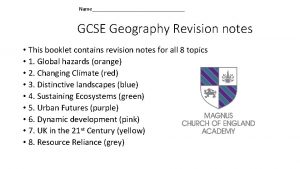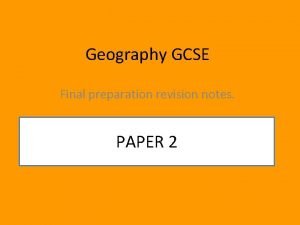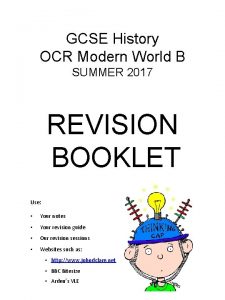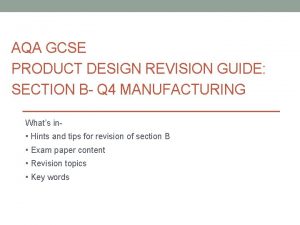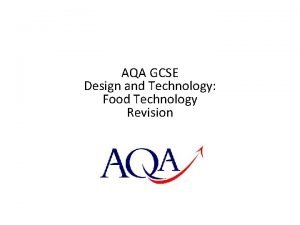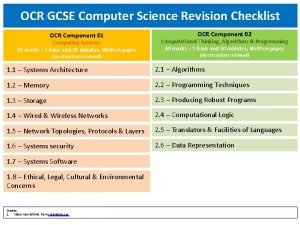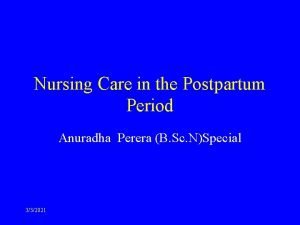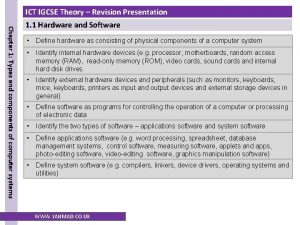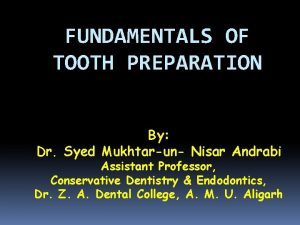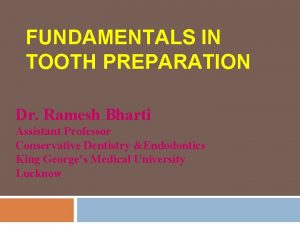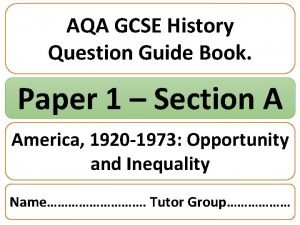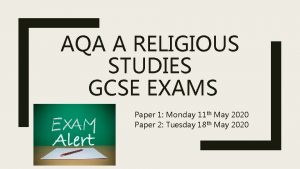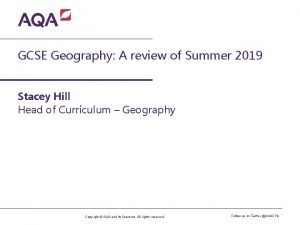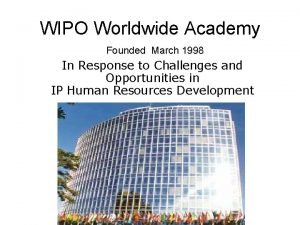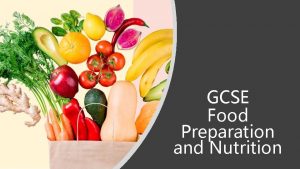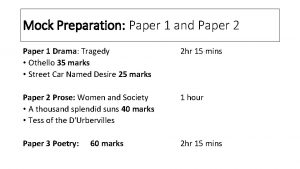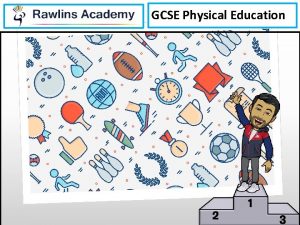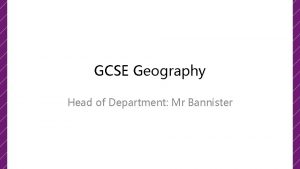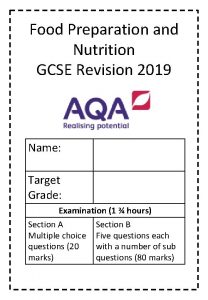Geography GCSE Final preparation revision notes PAPER 2















































- Slides: 47

Geography GCSE Final preparation revision notes. PAPER 2

THE URBAN WORLD

1. What is the definition of urbanisation? This is the proportion of the world’s population who live in cities. This number is growing. 2. Name two factors that affect the rate of urbanisation. Natural population growth. Rural to urban migration. 3. Describe how the rate of urbanisation varies between HIC’s and LIC’s. In most HIC’s 60% of the world’s population lives in cities. In countries in South and South East Asia this is around 50%. In Africa the average is 20 -40%. The fastest growth is in India, China and Nigeria.

4. Rural to urban migration is created by push and pull factors. Name at least four push and four pull factors. Push factors from rural areas: farming is hard and poorly paid, poor harvest can lead to famine, there are few services like doctors, hospitals and schools and the areas tend to be isolated due to poor roads. Pull factors to urban areas: more well paid jobs, higher standard of living, better medical facilities and better access to transport. 5. What is the definition of a megacity? A city with a population of over 10 million people. 6. What are three types of megacity? Name an example of each one. 1. Slow growing such as LA. 2. Growing such as Rio de Janeiro. 3. Rapidly growing such as Lagos.

URBAN GROWTH – OPPORTUNTIES AND CHALLENGES IN A NEE (RIO DE JANEIRO)

1. Where is Rio de Janeiro? On the Atlantic coast of Brazil around Guanabara Bay. 2. Why is Rio important (regionally, nationally and locally)? Regionally – manufacturing is centred here with jobs in clothing, furniture, processed foods and service jobs in finance and insurance. Nationally – it is the cultural capital of Brazil and is home to a major port importing and exporting goods to and from Brazil. Globaly – it is a UNESCO world heritage site and has hosted global sporting events including the World Cup and Olympic Games. 3. What are the two causes of the growth of Rio? Natural population growth. Rural to urban migration, mostly due to drought in the North East of Brazil, causing many people to leave this area and international migration from other South American countries.

4. Describe and explain how the growth of Rio has created challenges and what these challenges are (managing slums and squatter settlements, providing clean water, sanitation an energy, providing health and education, reducing unemployment and crime and managing environmental issues such as waste, air and water pollution and traffic congestion). Managing slums and squatter settlements: houses are poorly constructed, steep slopes means risk of landslides, limited road access, lack of services, unemployment rates are high, crime including drugs and murder are high, IMR are high, waste is hard to get rid of and is often burned. Providing clean water and sanitation: 12% of the population does not have running water. Energy: there are regular blackouts and people tap illegally into the mains supply which is risky and unsafe. Health: only 55% of some parts of the city have access to a clinic. Education: only half of children continue in school after the age of 14. Unemployment: over 20% in some favelas and many people have informal jobs. Crime: serious crime is an issue including murder, kidnappings and street robbery as well as significant drug related crime. Environmental issues: air pollution causes 5, 000 deaths a year, travel by car has increased by 40% in the last 10 years, water flowing into the bay is heavily polluted, waste collection lorries cannot access favelas.

5. Describe and explain the opportunities created by the growth of Rio (this must include social opportunities: health and education, and economic opportunities: access to resources including energy and water opportunities). Social opportunities: taking health care directly into people’s homes in the favelas such as disease testing which reduces infant mortality rates, opening a university in Rochina favela, paying for free sports lessons in volleyball and football, encouraging local people to volunteer in schools. Economic opportunities: trying to encourage more people to take formal jobs rather than informal ones in tourism, manufacturing, construction, retail and services. Providing free child care for teenage parents who want to continue their education. Improving access to resources: building seven new water treatment plants to improve water quality and laying new pipes in favelas. Installing new power lines and generators as well as developing new HEP schemes. Improving the environment: new toll roads and one way systems to reduce traffic congestion, new sewage works and pipes and fines for ships emptying fuel into the bay, power plant built to run on rubbish and waste.

6. An example of how urban planning is improving the quality of life for the urban poor. A 3 CASE STUDY SHEET/ FLASHCARD ACTIVITY RIO Can I give details of a project aimed at improving the lives of the urban poor and evaluate its successes and failures? FAVELA BAIRRO PROJECT

WHERE DO PEOPLE LIVE IN THE UK?

1. How many people live in the UK? Approx 64. 6 million in 2015 2. Is the UK’s population evenly or unevenly distributed? Unevenly distributed – 1 in four people live in London and the South East. 3. How has industrial development in the past and the location of raw materials influenced the UK’s population distribution? Most cities grew and developed during the industrial revolution. The cities are located near to the raw materials needed by the industries such as coal and iron, including Manchester. 4. What are three main changes affecting where people in the UK might live in the future? The population is generally drifting south east towards London. Immigration has grown and most migrants settle in cities. Recently more older people are moving to live in rural areas.

URBAN CHANGE IN THE UK - BRISTOL

1. Where is Bristol? Bristol is the largest city in the South West of England. 2. Why is Bristol important (in the UK and the wider world)? UK: Bristol is one of the UK’s 10 ‘core cities’ , it has two universities, the largest concentration of computer chip production outside of America, is the UK’s 8 th most popular tourism destination, has several music and theatre venues, is home to Aardman animations and has two cathedrals. World: It is well connected to Europe via London, it has a major airport, has developed global industry such as defence and aerospace technology, attracts a high level of foreign investment from big companies like BMW and Airbus and attracts students from all over the world. 3. Describe the impacts migration has had on the growth and character of Bristol. Half of Bristol’s population growth is due to international migration, mostly from the EU and many stay permanently. Positives: contribute to culture, improve skills levels, younger people balance ageing population, contribute to the economy. Issues: integration can be challenging, pressure on education and housing.

4. Describe and explain how urban change has created social, economic and environmental opportunities in Bristol? (social and economic – culture, recreation and entertainment, employment and integrated transport and environmental – urban greening). Social opportunities: vibrant young music scene, two popular football teams, out of town shopping centre built, shopping facilities in town centre improved. Housing is being created on brownfield sites. Economic opportunities: hi-tech industry has been developed, £ 100 million has ben spent on super fast broadband, the university is helping to create jobs in research, the defence supply agency has built a site (however this is on greenfield land contributing to urban sprawl). Integrated transport: different transport types have been connected to make journeys smoother, park and ride sites have been created and electricity lines electrified, over 100 electric car charging points created. Environmental opportunities: nature reserves have been given protected status, every primary pupil will get a chance to plant a tree, a wildlife network is to be developed. This is all part of a ‘green’ action plan known as urban greening, more recycling is to be done and work is underway to reduce air pollution such as reducing speed limits on motorways.

5. Describe and explain how urban change has created social, economic and environmental challenges in Bristol? (Social and economic – urban deprivation, inequalities in housing, education, health and employment and environmental – dereliction, the greenfield v brownfield debate, waste disposal). Social challenges: some areas have high levels of social deprivation and there are inequalities in parts of the city like the differences between Filwood and Stoke Bishop. There is also an issue with a shortage of housing and growth on the rural urban fringe which can cause issues when green belt land is lost. This has led to the greenfield v brownfield debate. Economic challenges: the closure of the cities port left empty warehouses, people who lacked skills to work in new industries and generated unemployment. These run down areas show signs of urban deprivation. Environmental challenges: there are many derelict urban areas, demand for new homes has led to urban sprawl and building on greenfield land, Bristol produces a higher than average level of waste, especially food waste, traffic congestion leads to air pollution (200 people a year die from this).

6. Describe the impact of urban sprawl on the rural-urban fringe and how this has led to the growth of commuter settlements. Many new houses in Bristol have been developed on the edge of the city, especially in the North West. New towns like Bradley Stoke have been created. This has led to the loss of some greenfield land. The people who move here still need to travel to the city to work in the centre of the city (commuters), contributing to increased traffic congestion and air quality issues. To tackle the issue, more homes need to be built on brownfield land. 7. An example of an urban regeneration project. A 3 CASE STUDY SHEET/ FLASHCARD ACTIVITY BRISTOL Can I give details of an urban regeneration project including why it was needed and the main features? TEMPLE QUARTER REGENRATION PROJECT

SUSTAINABLE URBAN DEVELOPMENT - FREIBURG

1. What does urban sustainability mean? Urban sustainability is about addressing the many issues we have in cities like Rio and Bristol. It involves solving environmental concerns but also looking at the effects on people socially and economically. 2. Name three main features of sustainable urban development. To be sustainable a goal or action has to meet the needs of future and present generations environmentally, socially and economically. 3. Describe how urban transport strategies can be used to reduce traffic congestion. Traffic congestion leads to air pollution, longer journey times, higher fuel consumption and greater risks of accidents. Freiburg, like Bristol, has an integrated transport system but theirs is based on trams. Trams are efficient, cheap and accessible. Tram journeys have increased by over 25, 000. They have also developed cycle paths and restrictions on car parking spaces.

4. An example of sustainable urban development. A 3 CASE STUDY SHEET/ FLASHCARD ACTIVITY FREIBURG Can I give details of a range of sustainable urban management strategies used in Freiburg?

THE DEVELOPMENT GAP

1. What is development? Development means positive change that makes things better. This means an increase in standard of living and quality of life. The development gap is the difference in standards of living between the world’s richest and poorest countries. 2. Describe the difference between quality of life and standard of living. Standard of living looks at income and wealth levels. Quality of life looks at the well being of a person or place. 3. Name 10 development indicators. Give a mix of economic and social measure s. GNI, life expectancy, number of years in education, birth rate, death rate, HDI, IMR, number of doctors per 1000 people, literacy rate, % of population with safe water. 4. What are the limitations of economic and social measures of development? Data can be out of date or hard to collect, data may be unreliable, economic indicators can hide issues like debt or informal economies.

5. Name and describe the five stages of the demographic transition model, including the names of countries at each stage. The DTM shows changes over time in the population of a country. It shows BR, DR and NI (the difference between the birth rate and death rate). It is linked to development because as a country develops it’s population features change. Stage 1 High BR, High DR, traditional rainforest tribes – stable population. Stage 2 High BR, falling DR, Afghanistan – population grows. Stage 3 BR drops, death rate continues to fall, Nigeria – growth slows. Stage 4 Low BR, low DR, , UK. Stage 5 BR falls below DR, Japan – population may decrease. 6. Use the space below to draw a population pyramid representing each stage of the demographic transition model.

7. Name and describe the major causes of uneven development (physical, human and historical). Physical: landlocked countries, climate related diseases and pests, extreme weather and natural disasters, lack of safe clean water. Human: trade, poverty, low life expectancy, disease and illness. Historical: colonialism and the conflict resulting from the fight for independence, civil war and political struggle, changes in power. 8. Describe and explain how uneven development has led to disparities in health and wealth. GNI (wealth indicator) is the total value of goods and services and is highest in HICs. 5% of the population of HICs hold 35% of the world’s total wealth. NEEs are seeing their share of wealth increase rapidly. Africa’s share of global wealth is less than 1%. LICs are unable to invest on good quality health care and so there are vast differences between LICs and HICs. This is shown in deaths of under 15’s which is 4 in 10 in LICs and 1 in 100 in HICs. The occurrence of Malaria is another good example of the link between health and development.

9. Describe and explain how uneven development has led to disparities in migration. Migration is the movement of people from place to place. There are many different types and reasons for moving such as forced or voluntary migration. People can be classed as economic migrants, refugees and displaced persons. Some areas have seen emigration such as Syria as a result of civil war and some areas such as the UK have experienced immigration. Migration brings advantages for host countries such as skilled workers and tax income as well as disadvantages such as pressure on services like health end education. 10. Describe how each of these strategies can help to reduce the development gap: Foreign investment: TNC’s create the PME including jobs, new industries and infrastructure. Industrial development: brings employment, higher income, the PME, self reliance. Tourism: income from abroad can be spent on education and housing but is vulnerable. Aid: there are many types of aid, with donors and recipients. Aid needs to be appropriate like the example of Goat Aid from Oxfam and technology which needs to be intermediate. Intermediate technology: these are small scale, sustainable projects in local communities. Fair trade: this seeks to improve the quality of life for farmers through fair pricing. Debt relief: countries spend money on projects like education instead of repaying loans. Microfinance loans: small scale loans for poor people to start business and become selfsufficient.

11. An example of the growth of tourism in an LIC or NEE. A 3 CASE STUDY SHEET/ FLASHCARD ACTIVITY JAMAICA Can I give details of how growth in tourism can help to reduce the development gap?

RAPID ECONOMIC DEVELOPMENT IN LICS AND OR NEES - NIGERIA

1. Where is Nigeria? Nigeria is in West Africa. It has regions which are hot and wet in the South and a long, dry seasons inland away from the coast where it meets the Atlantic Ocean. 2. Why is Nigeria important? Regionally and globally? Regionally – it has the highest population in Africa, one of the largest industrial areas, it has the highest farm output in Africa and is seen as a role model for other African countries despite its many issues (lack of infrastructure, poor roads, power cuts). Globally - Nigeria is a NEE, experiencing rapid economic development, it is now the world’s 21 st largest economy, it is the 12 th largest supplier of the world’s oil and Nigeria regularly contributes peacekeeping troops on global missions. 3. What are the current main features of Nigeria, socially, politically and culturally? Politically – Nigeria has had a stable government since 1999. This has encouraged other countries to invest in it, especially China and South Africa. Big business like Wal-Mart, Microsoft and IBM are also investing. Socially – there are many ethnicities and religions with clear tension between some. Islamic fundamentalist groups have been active such as Boko Haram which might threaten investment. Cultural – Niger has ‘Nollywood’, well known literature and many premier league based football players.

4. Describe how the industrial structure of Nigeria has changed. Employment in agriculture has fallen as more work is done by machinery (primary). Employment has grown in the oil industry, manufacturing and construction (secondary). Employment has grown in retail, communications and finance (service/tertiary). These changes mean that Nigeria now has a more balanced economy. Why have these changes happened? advances in technology, investment in science and training, large number of the population speak English, increase in ICT skills. 5. Explain how the growth of manufacturing is affecting economic development. Manufacturing now accounts for 10% of Nigeria’s GDP. This has stimulated economic growth through the PME. Regular paid work means people are spending more, suppliers to industry are getting more orders, tax income is increasing, the country is attracting foreign investment. 6. What role do TNC’s play in Nigeria, and what advantages and disadvantages have they brought to their host country? A TNC is a large company that operates in other countries. An example in Nigeria is Unilever. They develop products for Nigerians and have set up programmes to improve health, education and water supply. Advantages: employment, money, investment, PME. Disadvantages: pay and working conditions can be an issue, some profit goes abroad. Money used to attract these companies could be spent directly in Nigeria.

7. What types of aid has Nigeria received and what impact has this aid had? Aid is defined as ‘assisting people’. There are many types. Emergency aid usually follows a natural disaster, war or conflict. Development aid is long term support from charities and governments and aims to improve quality of life through safe drinking water, education, roads and electricity supply. Nigeria has seen economic growth but there are still many poor people who live on less than $1 a day. BR and IMR are still high and life expectancy is low. Nigeria receives about 4% of aid given to Africa. Mostly from the UK and USA. There has been a lot of success in small, community based projects led by NGO’s. Many projects have been funded including in health education related to HIV and AIDS and the importance of immunisations. 8. Describe some of the environmental impacts of economic development in Nigeria. The growth of industry has caused air pollution, economic damage, breathing issues, deforestation and desertification. The growth of cities has led to the development of squatter settlements, issues with waste disposal and serious traffic congestion. The growth of commercial farming has led to soil erosion and water pollution, added to CO²emissions and reduced biodiversity levels. Mining and oil extraction have led to severe soil pollution, regular spills and violent conflict such as the issues faced in Bodo.

9. Describe how the growth and development of Nigeria has affected the quality of life for the people who live there. HDI is increasing – one of the fastest growing in the world. There are generally more reliable and better paid jobs, higher disposable income, better services, better diet, more reliable electricity supply, better health care, improved infrastructure. However there are still many poor people with limited access to services and the gap between Nigeria’s rich and poor is growing. One of the major issues is still oil and corruption in this industry. The government needs to stay stable, pollution in the Niger delta due to oil needs to be addressed and work needs to be done to address the issues of militant groups like Boko Haram for improvements to continue.

THE CHANGING ECONOMY OF THE UK

1. How has the economy of the UK changed? 2. Describe what is meant by the term deindustrialisation. 3. What is globalisation? In the last few decades there has been a big shift from people working in manufacturing to services like health care, finance and retail. There has also been development in the quaternary industry with jobs in research, ICT and media. The decline of manufacturing and traditional industries like coal mining at the same time is called de-industrialisation. This happened as people have been replaced by machines and companies choose to locate production abroad. Many people in the UK now work in global industries and for global companies as part of a process called globalisation. This is where countries trade, communicate and exchange people, ideas and culture on a global scale. 4. Which key government policies have influenced the UK’s economy? 1945 - 1979 Government spent money ‘propping up’ industries which were becoming unprofitable. Potential job cuts caused strikes across the UK. 1979 -2010 Government sold off it’s industries to private companies which then cut costs and jobs to maximise profits or closed industry and set up new business like finance. 2010 to present Government has tried to rebalance the economy by supporting the return of some industries by developing transport and making loans easier for industry to get.

5. Describe what is meant by a post-industrial economy and what key features this economy will have (include development of ICT, service industries, finance, research, science and business parks). Post-industrial is where manufacturing has declined and been replaced by service and quaternary industries. Together these two now employ 88% of people in the UK. The main areas developed are: ICT: internet access has transformed our economy and many business have developed based around ICT, employing over 1. 3 million people. The UK is one of the world’s leaders in ICT. Service industries and finance: many people now have jobs where they provide a service instead of make a product. The UK is the world leader in finance and employs 2 million people. Research: highly skilled people, many working in universities generate over £ 3 billion. Examples include research for the BBC, British Antarctic Survey, the NHS and the Ministry of Defence. Science parks: to stimulate this growth there are over 100 science parks in the UK where researchers share facilities and knowledge, working close to each other. They are close to universities, have good transport links and green spaces/good facilities like gyms for workers. Business parks: this is where business groups together. They tend to be on the edge of cities where land is cheaper and access to motorways is easy.

6. Describe the impacts that industry can have on the physical environment. Industry can look dull and spoil landscapes. Industrial processes can cause water and air pollution. Industry produces waste which can itself cause pollution and be difficult to dispose of. Transporting goods to and from industrial sites can add to air pollution. 7. An example of how modern industrial development can be more environmentally sustainable. . A 3 CASE STUDY SHEET/ FLASHCARD ACTIVITY TOR QUARRY Can I give details of how quarrying in the UK can be developed more sustainably?

8. An example of major changes taking place in a rural area where the population is declining. . A 3 CASE STUDY SHEET/ FLASHCARD ACTIVITY THE OUTER HEBRIDES Can I give details of how the declining population of a rural area is causing social and economic effects? 9. An example of major changes taking place in a rural area where the population is growing. . A 3 CASE STUDY SHEET/ FLASHCARD ACTIVITY SOUTH CAMBRIDGESHIRE Can I give details of how the growing population of a rural area is causing social and economic effects?

10. Describe the improvements being made in road and rail infrastructure, port and airport capacity. Road improvements: £ 15 billion road improvement strategy, 100 new roads by 2020, 1300 miles added as new lanes to motorways, creation of smart motorways. Essential for economic growth all over the UK. Rail improvement: electrification of train lines in the north of England to reduce journey times, £ 50 billion investment in HS 2 to connect London and Birmingham to places in the north and crossrail which is a new underground network in London to ease congestion on roads. Essential for growth in the North of England links to Europe. Ports: the UK has the largest port system in Europe with 32 million passengers a year as well as trade in goods. Liverpool 2 is a plan to double the size of Liverpool’s main container port. Essential for boosting the economy of the North West. Airports: new runway planned for Heathrow airport, lengthening of existing runways at Heathrow, building a new airport in the Thames estuary. All of these changes have potential SEE impacts both positive and negative such as creating thousands of new jobs to loss of land, people’s homes and businesses to make way for new projects and potential noise and air pollution issues.

11. What is the north-south divide and what can be done to reduce it? In general the south of the UK has a higher standard of living, longer life expectancy and higher incomes than the north. One reason for the divide is the decline of manufacturing, many of which were in the North. To help close the divide the government and EU have supported the north for new business and new infrastructure, foreign investment has been encouraged such as the location of Nissan in the north east and in 2015 the government launched the Northern Powerhouse to support investment in Liverpool and Manchester such as the developments in transport referred to in question 10. 12. What position does the UK have in the wider world and how it is linked to the rest of the world through trade, culture, transport and electronic communication as well as its membership of the EU? The UK is seen as a fair, tolerant law- abiding society with a rich culture. It is a member of many influential groups like G 8, NATO and the UN security council. Trade: the UK has strong links with the EU and America and trades by land, air, sea and increasingly online. You may refer to recent changes surrounding BREXIT. Culture: the importance of English as a language has developed strong cultural links in music, TV, art and fashion. Transport: the UK is home to two of the world’s busiest airports. Electronic communication: a multi billion dollar system of sea floor cables connects the UK to the world and new cables are currently being laid between London and Tokyo.

RESOURCE MANAGEMENT

1. What is a resource? A stock or a supply of something that has a value or a purpose. 2. Is the distribution of resources across the world even? No. the distribution is uneven between HICs and LICs, especially in sub-Saharan Africa. 3. What is the recommended calorie intake per day? Between 2000 -4000 per day depending on age and gender. 4. Over one billion people do not get the recommended daily intake. What are these people in danger of becoming? Undernutrition or malnutrition causes a range of illness and disease. This can have economic effects when people can’t work. 5. Describe why water is essential for our well- being. Water is essential for our health but also for growing the crops we need for food and in the production of the energy we need for our daily lives. 6. What are the main causes of an imbalance of water supply across the world? Mostly due to variations in climate and rainfall. Water use is also a factor. 7. Why is energy consumption generally increasing around the world? Countries are becoming more developed so demand is increasing.

RESOURCES AND THE UK

1. Describe how our demand for food in the UK is changing. We are importing more of our food from other countries. 2. What are the main impacts of importing food to the UK? Transporting food is expensive so prices go up and this is bad for the environment as food miles have a carbon footprint, contributing to climate change. 3. How are we responding to our food challenges? We are trying to grow more of our own food for greater food security as well as eat more seasonal foods. Two growing trends are: Agribusiness: intensive farming using chemical to maximise growth on the edge of towns so food travels less to customers. Organic produce: using less chemicals, burning local and seasonal food. 4. There is an increasing demand for water in the UK. What are the main causes? Growing population, more houses being built, increase in use of water using appliances in the home. 5. Does the supply of water in the UK match the location of the demand (areas of deficit and surplus)? No. The North and West have a water surplus where supplies from rivers, reservoirs and aquifers are high and the South West has a water deficit, where demand is greater than supply.

6. Describe how water transfer could help to maintain supplies. The UK would like to transfer water from areas with a surplus to areas with a deficit. However at present these plans are not possible due to the high cost, impact on wildlife and greenhouse gases created during transfer. 7. Describe how we monitor water quality and any issues we have with pollution. The Environment Agency has done a lot to improve water quality in the UK, including: monitoring, filtering, purifying, restricting use and imposing fines. Work still needs to be done to improve and protect some groundwater supplies from pollution caused by farming, industry and power stations. 8. Describe and explain the main changes in the UK’s energy mix. We are moving towards using more renewable energy sources. We are importing more of our energy from abroad such as natural gas, reducing our energy security. We are moving towards using less fossil fuel based energy and increasing nuclear power but fossil fuels will remain important due to the planned exploitation of shale gas (fracking). 9. Choose one energy source and describe the issues associated with its exploitation/extraction. Fracking is a new way of extracting shale gas. Issues and concerns include the contamination of drinking water, drilling many bore holes, the release of methane gas, possible small tremors, transport to and from drilling sites, conflict with local communities.

FOOD

1. Which areas of the world generally have food surplus (security) and food deficit (insecurity)? Canada, USA and Europe consume the most food, over 3400 calories a day. The average for a country is 2000 -2400. In sub-Saharan Africa it is below 2000 where food insecurity is common. 2. Global food consumption is increasing. Name two main reasons for this. Increased level of development mean people have more money to spend on food. There is a greater availability of food due to improvements in transportation and storage. 3. Describe the main factors that affect food supply (at least six). Climate – areas with extreme climate struggle to grow food. Climate change - warmer climate might encourage weeds and pests. Lack of technology such as poor use of irrigation. Lack of water. Conflict. Poverty.

4. Describe the main impacts of food insecurity. Food insecurity is when a country can’t supply enough food to feed it’s population. Famine: widespread shortage of food leading to malnutrition such as in Somalia in 2012. Undernutrition: lack of a balanced diet causing a deficiency in vitamins and minerals. Soil erosion: people trying to grow food in difficult areas cause overgrazing, over cultivation and deforestation causing soil erosion and degradation. Rising prices: caused by rising costs in transport and fertilizers. LICs/NEEs hit hardest. Social unrest: high rises in the price of food can lead to food riots for example in 2011 when the price of cooking oil and flour doubled, leading to five days of riot in Algeria. 5. Identify a range of strategies, which can be used to increase food supply. Irrigation: artificial watering of land by taking water from rivers or aquifers. There are examples of very large projects such as IBIS an small scale examples such as Makueni. Aeroponics: spraying plants with a fine mist of nutrient rich water. Hydroponics: plants are grown in gravel or mineral rich water. The ‘new’ green revolution – using a range of strategies in India to increase rice production. Biotechnology – use of genetically modified crops which produce higher output. Appropriate technology – using small-scale, locally skilled projects such as water harvesting or using cycle power.

6. An example of a large-scale agricultural development. A 3 CASE STUDY SHEET/ FLASHCARD ACTIVITY INDUS BASIN IRRIGATION SYSTEM (IBIS) Can I give details of the advantages and disadvantages of the system? 7. Describe a range of strategies that could be used to sustainably improve food supply. Organic farming: farming without the use of chemicals. Permaculture: natural farming based on organic farming, crop rotation, managing woodland. Urban farming/Agribusiness: growing food on the edges of or in towns and cities, close to the people who consume the produce creating jobs, green spaces and habitats for species like birds and butterflies. Sustainable fishing: setting quotas, avoiding breeding grounds, reducing use of chemicals in fish farming. Meat from sustainable sources: small-scale free range farms using organic methods. Meat can be more expensive but animal welfare is better.

8. An example of a local scheme in a LIC or NEE to increase sustainable supplies of food. A 3 CASE STUDY SHEET/ FLASHCARD ACTIVITY MAKUENI, KENYA Can I give details of the project?
 Geography gcse revision notes
Geography gcse revision notes Geography paper 2 revision notes
Geography paper 2 revision notes Describe watershed
Describe watershed Edexcel geography gcse checklist
Edexcel geography gcse checklist Active and passive vocabulary
Active and passive vocabulary Gcse pe revision booklet
Gcse pe revision booklet Gcse maths revision ppt
Gcse maths revision ppt Revision techniques gcse powerpoint
Revision techniques gcse powerpoint History gcse spec
History gcse spec Gcse catering revision
Gcse catering revision Product design gcse revision
Product design gcse revision Food technology gcse revision
Food technology gcse revision Gcse pe revision booklet
Gcse pe revision booklet Computer science component 1
Computer science component 1 Catering gcse revision
Catering gcse revision Aqa maths gcse revision guide
Aqa maths gcse revision guide Revision techniques gcse powerpoint
Revision techniques gcse powerpoint Lochia color
Lochia color Wjec criminology revision notes
Wjec criminology revision notes Romeo and juliet revision notes
Romeo and juliet revision notes Tsotsi revision notes
Tsotsi revision notes Ict igcse notes
Ict igcse notes Ellipse revision notes
Ellipse revision notes Geography paper 1 case studies aqa
Geography paper 1 case studies aqa Mental preparation gcse pe
Mental preparation gcse pe Jelaine fauce
Jelaine fauce Gcse art sketchbook checklist
Gcse art sketchbook checklist Locks in cavity preparation
Locks in cavity preparation Strongest enamel margin
Strongest enamel margin Sample design and technology gcse examination paper answers
Sample design and technology gcse examination paper answers Sample design and technology gcse examination paper answers
Sample design and technology gcse examination paper answers Sample design and technology gcse examination paper answers
Sample design and technology gcse examination paper answers Edexcel gcse english language comparison question
Edexcel gcse english language comparison question English language paper 2 transactional writing
English language paper 2 transactional writing Gcse edexcel english literature past papers
Gcse edexcel english literature past papers History paper 1
History paper 1 Rs aqa gcse past papers
Rs aqa gcse past papers Technology student
Technology student Gcse computer science paper 2
Gcse computer science paper 2 The lovely bones language paper 1 answers
The lovely bones language paper 1 answers Stock preparation in paper making process
Stock preparation in paper making process Aqa gcse geography
Aqa gcse geography Ccea data leaflet
Ccea data leaflet I am not contraction
I am not contraction Wipo dl-101 final exam questions
Wipo dl-101 final exam questions World geography final jeopardy
World geography final jeopardy World history final exam study guide
World history final exam study guide Paper 2 aice general paper
Paper 2 aice general paper
